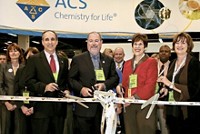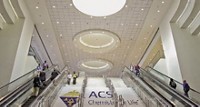Advertisement
Grab your lab coat. Let's get started
Welcome!
Welcome!
Create an account below to get 6 C&EN articles per month, receive newsletters and more - all free.
It seems this is your first time logging in online. Please enter the following information to continue.
As an ACS member you automatically get access to this site. All we need is few more details to create your reading experience.
Not you? Sign in with a different account.
Not you? Sign in with a different account.
ERROR 1
ERROR 1
ERROR 2
ERROR 2
ERROR 2
ERROR 2
ERROR 2
Password and Confirm password must match.
If you have an ACS member number, please enter it here so we can link this account to your membership. (optional)
ERROR 2
ACS values your privacy. By submitting your information, you are gaining access to C&EN and subscribing to our weekly newsletter. We use the information you provide to make your reading experience better, and we will never sell your data to third party members.
Environment
Chemists Gather in Anaheim
Spring national meeting draws more than 13,000 scientists
by LINDA RABER
April 5, 2004
| A version of this story appeared in
Volume 82, Issue 14

At the ACS National Meeting, held from March 28 to April 1 in Anaheim, Calif., more than 8,000 research papers were presented, and the largest ever ACS chemical exhibition on the West Coast--with nearly 500 booths--took place. The meeting drew just over 13,000 scientists and exhibitors to sunny Southern California.
A general theme of the meeting--nanotechnology--was reflected in several presidential sessions sponsored by ACS President Charles P. Casey: "Big Promise from Small Science: How Nanotechnology Will Change Our Lives," "Commercial Applications of Nanotechnology," and "Working in Nanotechnology: What Does It Take?"
Job seekers and graduate students listened as four leaders in nanotechnology business--Harris A. Goldberg, president and CEO of InMat; Margaret L. Blohm, manager of GE's nanotechnology program; Charles Z. Hotz, director of R&D at QuantumDot; and James C. Romine, director of materials science and engineering at DuPont--described the adventurous and unusual paths that led them to successful careers at the forefront of nanotechnology. Although each leader took a different route, all agreed that a strong, multidisciplinary scientific background, coupled with the courage to take risks, was key to getting them where they are today.
Jobs were on the minds of many meeting attendees. At this time of record-high unemployment for chemical scientists, ACS Career Services held 63 mock interviews, 151 résumé reviews, and 36 career workshops. NECH, the ACS employment center at national meetings, was active with 1,281 job seekers, 121 employers, and 1,579 scheduled interviews for 271 positions posted. (By comparison, last spring in New Orleans, 1,151 job seekers registered with NECH, as did 96 employers, with 151 representatives; 305 positions were posted, and 1,751 interviews were scheduled.)
In governance actions, the ACS Council voted to raise dues for 2005 to the fully escalated rate of $123.
Also at the council meeting, four candidates for 2005 president-elect--Edward M. Eyring, University of Utah; F. Sherwood Rowland, University of California, Irvine; Gary B. Schuster, Georgia Institute of Technology; and Isiah M. Warner, Louisiana State University--were introduced and gave short presentations. The council selected Rowland and Warner as candidates for 2005 president-elect. After announcing the results of the council election, Committee on Nominations & Elections Chair Valerie J. Kuck also announced that E. Ann Nalley, Cameron University, had been certified as a petition candidate for 2005 president-elect.
The Committee on Budget & Finance reported that ACS's overall financial performance for 2003 was favorable, despite serious financial challenges during the year. The society ended the year with a net deficit from ACS operations of $64,000. This year-end financial performance was $811,000 favorable to the 2003 approved budget. And, for the first time in three years, the society's financial performance, including investment gains, resulted in an increase to unrestricted net assets.
Year-end 2003 membership in ACS, at 159,332, was essentially unchanged from year-end 2002. The good year-end news is that the number of student members increased by nearly 4%, and the number of recent graduates who enrolled as members increased by 50%.





Join the conversation
Contact the reporter
Submit a Letter to the Editor for publication
Engage with us on Twitter